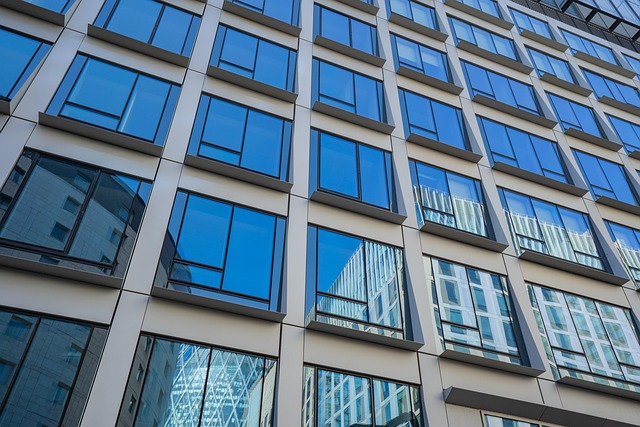Commercial air doors have evolved from manual to automatic operations thanks to technological advancements, enhancing user experience and energy efficiency. Modern motion sensors detect human presence, enabling automatic door activation and sealing gaps to optimize climate control in various settings. Heated air doors are expected to gain popularity for their dual benefits, while integration with building management systems will further improve temperature regulation and airflow in industrial entrance solutions. Regular maintenance and customization based on location-specific needs are crucial for optimal performance.
Automatic commercial air doors, powered by motion sensors, are transforming the way businesses manage entry points. This technology offers enhanced security, improved customer experience, and energy efficiency. In this article, we explore the evolution of commercial air doors, delve into the role of motion sensors as the new standard in activation, discuss benefits for businesses, provide installation and maintenance considerations, and look at future trends shaping this dynamic sector.
- Understanding Commercial Air Doors' Evolution
- Motion Sensors: The New Standard in Activation
- Benefits of Automated Door Systems for Businesses
- Installation and Maintenance Considerations
- Future Trends Shaping Commercial Door Technology
Understanding Commercial Air Doors' Evolution

Commercial air doors have evolved significantly over time, transitioning from simple, manually operated mechanisms to sophisticated, automatic solutions driven by advanced technology. Historically, commercial entrance air barriers were primarily designed to prevent drafts and regulate climate control in retail stores, warehouses, and industrial facilities. These traditional doors often relied on manual activation, requiring users to push or pull them open, which could be inefficient and time-consuming.
Today, the landscape of commercial door systems has changed dramatically with the advent of motion sensors and other smart technologies. Heated air doors, HVAC air curtains, and energy-efficient barriers now incorporate advanced sensor technology to automatically activate when someone enters or leaves a space. This not only enhances convenience for occupants but also contributes to improved climate control, reducing energy consumption in buildings. Such innovations represent a significant shift towards modern, efficient, and user-friendly industrial entrance solutions.
Motion Sensors: The New Standard in Activation

Motion sensors have emerged as the new standard in activating commercial air doors, revolutionizing the way we control indoor environments. These advanced technologies play a pivotal role in enhancing energy efficiency and climate control in various settings, from retail stores to warehouses. By employing sophisticated algorithms and infrared or laser technology, motion sensors can accurately detect human presence, triggering the automatic opening and closing of commercial air doors.
This innovative approach not only offers unparalleled convenience but also contributes to significant cost savings and improved sustainability. Unlike traditional mechanisms, motion-activated systems eliminate the need for constant power consumption, making them ideal for applications requiring energy-efficient barriers like heated air doors or HVAC air curtains. As a result, industrial entrance solutions are transformed, with commercial door systems becoming smarter and more responsive to meet the demands of modern businesses while ensuring optimal climate control.
Benefits of Automated Door Systems for Businesses

Automatic commercial air doors equipped with motion sensors offer a multitude of benefits for businesses. Firstly, they enhance customer experience by providing seamless and hands-free entry, particularly in retail stores and industrial facilities. This feature is especially valuable in high-traffic areas where maintaining social distancing has become essential due to health and safety regulations.
Moreover, these automated door systems contribute to energy efficiency and climate control. Unlike traditional doors, commercial air doors, such as heated air doors and HVAC air curtains, act as entrance air barriers, sealing gaps and preventing the exchange of outside air, thereby reducing energy loss and maintaining optimal indoor temperatures. This is particularly beneficial in warehouses and other industrial entrance solutions where temperature control is crucial.
Installation and Maintenance Considerations

The installation of automatic commercial air doors equipped with motion sensors is a smart move for businesses aiming to enhance customer experience and energy efficiency. When integrating these advanced entrance systems, careful consideration should be given to ensuring optimal performance and longevity. Regular maintenance is key; cleaning sensors and replacing filters can prevent malfunctions caused by debris buildup or dust accumulation, especially in industrial or warehouse settings.
Additionally, understanding the specific needs of each location is vital. For retail spaces, energy-efficient barriers that regulate climate control doors could be ideal, while heated air doors might be more suitable for cold climates to provide both comfort and HVAC system support. Industrial entrance solutions should also consider the flow of goods and people, potentially employing robust, durable commercial door systems with customizable sensor settings to cater to varying traffic patterns.
Future Trends Shaping Commercial Door Technology

The future of commercial door technology is poised for significant advancements, driven by innovations aimed at enhancing user experience, improving energy efficiency, and providing better climate control. One prominent trend is the increasing adoption of advanced motion sensors and smart automation in commercial air doors. These intelligent entrance air barriers will not only ensure seamless entry and exit but also play a crucial role in managing HVAC systems, particularly in retail and warehouse settings.
As businesses seek more energy-efficient solutions, future commercial door systems are expected to incorporate innovative designs that reduce energy consumption without compromising on functionality. Heated air doors, for instance, can provide both climate control and effective separation of indoor and outdoor environments, contributing to significant cost savings. Industrial entrance solutions will continue to evolve with smart features, integrating seamlessly with existing building management systems to optimize temperature regulation and airflow, thereby enhancing the overall customer experience while minimizing environmental impact.
Automatic commercial air doors, powered by motion sensors, are revolutionizing access control. By embracing this technology, businesses can enhance customer experience, improve energy efficiency, and reduce operational costs. As we look ahead, advanced sensors, integrated AI, and smart building technologies will further refine the future of commercial air door systems, setting new standards for convenience, security, and sustainability.






